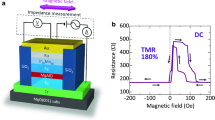Abstract
We have used highly charged ions (HCIs) such as Xe44+ to modify ultrathin aluminum oxide barriers in magnetic tunnel junctions (MTJs) in order to controllably adjust their electrical properties independently of oxide thickness. We have reduced the resistance area (RA) product of our MTJ devices by up to three orders of magnitude down to our present measurement uncertainty limit of 30 Ω·μm2 by varying the HCI dose. Preliminary experiments indicate that HCI modified Co/Al2O3/Co MTJs have a reduced magnetoresistance (MR) of ≈ 1% at room temperature as compared to ≈ 10% for undosed devices. The goal of this effort is to fabricate a magnetic field sensor in current-perpendicular-to-plane (CPP) geometry with an RA optimized for hard drive read heads. This is an improvement over presently demonstrated CPP architectures based on giant magnetoresistance or tunnel junctions, whose RAs are either to low or too high.
Similar content being viewed by others
References
T. Kuwashima, K. Fukuda, H. Kiyono, K. Sato, T. Kagami, S. Saruki, T. Uesugi, N. Kasahara, N. Ohta, K. Nagai, et al., “Electrical Performance and Reliability of Tunnel Magnetoresistance Heads for 100-Gb/in2 Application”, IEEE Trans. Magn. 40, 176 (2004).
K. Nagasaka, Y. Seyama, L. Varga, Y. Shimizu, and A. Tanaka, “Giant magnetoresistance properties of specular spin valve films in CPP structure,” J. Appl. Phys. 89, 6943 (2001).
S. S. P. Parkin, Z. G. Li, and David J. Smith, “Giant magnetoresistance in antiferromagnetic Co/Cu multilayers” Appl. Phys. Lett. 58 2710 (1991).
J. S. Moodera, L. R. Kinder, T. M. Wong, and R. Meservey, “Large magnetoresistance at room temperature in ferromagnetic thin film tunnel junctions”, Phys. Rev. Lett. 74, 3273 (1995).
Y. Nagamine, H. Maehara, K. Tsunekawa, D. D. Djayaprawira, N. Watanabe, S. Yuasa, and K. Ando, “Ultralow resistance-area product of 0.4 Ω (µm)2 and high magnetoresistance above 50% in CoFeB/MgO/CoFeB magnetic tunnel junctions”, Appl. Phys. Lett. 89, 162507 (2006).
T. Schenkel, A. V. Hamza, A. V. Barnes, and D. H. Schneider, “Interaction of slow, very highly charged ions with surfaces”, Prog. Surf. Sci. 61, 23 (1999).
G. Hayderer, S. Cernusca, M. Schmid, P. Varga, HP. Winter, F. Aumayr, D. Niemann, V. Hoffmann, N. Stolterfoht, C. Lemell, L. Wirtz, and J. Burgdörfer, “Kinetically Assisted Potential Sputtering of Insulators by Highly Charged Ions”, Phys. Rev. Lett. 86, 3530 (2001).
J. M. Pomeroy, H. Grube, A. C. Perrella, and J. D. Gillaspy, Nuclear Instruments & Methods in Physics Research Section B-Beam Interactions with Materials and Atoms (accepted 2006).
J. Gillaspy, “Highly charged ions”, Journal of Physics B: At. Mol. Opt. Phys. 34 R93 (2001).
A. Pikin, C. Morgan, E. Bell, L. Ratliff, J. Gillaspy, “A beam line for highly charged ions”, Reviews of Scientific Instruments 67 2528 (1996).
Author information
Authors and Affiliations
Rights and permissions
About this article
Cite this article
Grube, H., Pomeroy, J.M., Perrella, A.C. et al. Highly Charged Ion Modified Magnetic Tunnel Junctions. MRS Online Proceedings Library 960, 802 (2006). https://doi.org/10.1557/PROC-0960-N08-02
Received:
Accepted:
Published:
DOI: https://doi.org/10.1557/PROC-0960-N08-02




